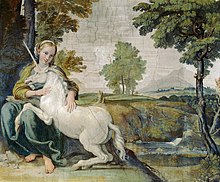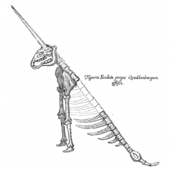unicorn
The unicorn (Latin unicornis , Greek monókeros ) is a mythical creature in the shape of a horse or goat with a straight horn on the middle of the forehead . It was best known in the Middle Ages through the Physiologus , is considered the noblest of all mythical animals and is a symbol of the good.
Reports
Antiquity
In antiquity , the unicorn is mentioned by Aristotle (384–322 BC), Pliny the Elder (23 / 24–79 AD) and Claudius Aelianus (around 200 AD ), among others . These reports go back to Ktesias of Knidos (around 500 BC), who reported in his strongly novel-like indica of unicorns in India that they are wild, fast and powerful, their horn has an antitoxic effect, which is why it was used at the court of the Achaemenids used as a drinking vessel. Pliny the Elder obviously meant a rhinoceros .
In Greek and Roman mythology, the unicorn does not occur, even not aware of any ancient pictures of unicorns. Whether the deer-like animal with a long, straight horn that branches out like palm trees at the tip, mentioned by Gaius Iulius Caesar (100-44 BC) in a probably pseudepigraphic description of the fauna of the Hercynian Forest , is a unicorn, is controversial.
In the Physiologus , an early Christian folk book written in Greek from the 2nd century AD with stories about wondrous animals, plants and stones, it is said that a unicorn can only be captured by a virgin, the virgin allegorically as the Virgin Mary , the unicorn was interpreted as Jesus Christ . The fact that it has only one horn refers to monotheism , that it resembles a little goat, to Christ's humility and the incarnation of God .
Bible

In several places in the Old Testament , the "Re'em" is mentioned, a strong and wild animal (for example Num 23.22 EU , Hi 39.9-12 EU , Ps 22.22 EU ). When the Hebrew text in the third century BC Was translated into Greek by the legendary 72 translators , they translated this word with μονόκερως monókerōs ( Gen. μονοκέρωτος), in German: unicorn. The Vetus Latina translates “unicornis” in these passages, the Vulgate also “rhinoceros” or “monoceros”. Martin Luther translated “unicorn”. According to popular belief today, what was meant was the wild bull or aurochs . The cause of the error was perhaps Babylonian reliefs and wall paintings, which only show the animals in profile, with only one of the two horns being visible. The belief that unicorns were found in the Bible was widespread well into the 18th century. Only Heinrich Sander pointed out the translation errors 1779th
Middle Ages and Early Modern Times
In the Middle Ages , unicorns are mentioned by Hildegard von Bingen (12th century), Albertus Magnus (13th century) and in pharmacopoeias, among others .
A (red) "carbuncle stone" suspected under the horn of the unicorn since the 12th century, as it was also sometimes assumed for dragons and other animals, should have extremely healing powers.
Marco Polo (1254–1324) reports in his travelogues (" Il Milione ") that he saw a unicorn in Sumatra . The description suggests that it was a Java rhinoceros or Sumatran rhinoceros . Other details also suggest that he did not see the animal himself, but only knew it from hearsay. The English adventurer Edward Webbe (1554–1590) claims to have seen three unicorns in the seraglio of an Indian sultan, whereas the Portuguese Jesuit Jerónimo Lobo (1593–1678) states that he met one in Ethiopia . The Scottish traveler John Bell (1691–1780) reports in 1713 that he saw one of these animals. According to Umberto Eco , these reports can be traced back to the formative power of the legends known to travelers before they left , which prompted them to report not only what they really saw, but also what they thought they must have seen.
In addition to the Bible, the Physiologus in particular was of particular importance for the Christian belief in unicorns until the early modern period , as was the case with the Swiss naturalist Conrad Gessner (1516–1565). For medieval alchemists , the unicorn, like the lion, symbolized the " Spiritus Mercurius" (Mercurius was the alchemical name for mercury ). The lion was appeased in the alchemical world through the worship of the unicorn, which stood for the active purity, the fertilizing sword and the penetrating power of the Mercurius spirit.
The British anthropologist John Layard (1891–1974) suspects in an episode of Ysgithyrwyn in the Welsh legend Mal y kavas Kulhwch Olwen ("How Kulhwch Olwen has won") a reference to the legendary unicorn.
present
Today unicorns are common as props in fantasy literature or as stuffed animals and children's toys . The railway company Locomore had taken this into account in its conditions of carriage : Unicorns can be taken on their trains for free when accompanied by at least one child under the age of 14, as long as the safety of fellow travelers is not endangered. Pink smoothies are sold as “unicorn puke” and pink plasticine (“ slime ”) is sold as “unicorn poop”. Since 2016 one can speak of a real unicorn hype. A unicorn chocolate that was sold out in a very short time is said to be significant. Experts call this hype a form of escapism
Hypotheses about the origin of the legend

From the time between about 2300 BC. BC and 1750 BC A large number of steatite seals, which show a unicorn-like animal, whose meaning is not clear, are preserved in the flourishing Indus culture . The animal occurs in different variations, in Mohenjodaro and Harappa one found images with a slightly curved horn like an aurochs or a zebu , animal figures with twisted antelope horns come from Chanhu Daro . All animals are shown strictly from the side and naturalistically, so it could be a cattle whose second horn is hidden behind the first. Similar lateral images of cattle with only one visible horn from Mesopotamia are discussed in connection with a possible common origin of the Indus culture and the Sumerians . The depictions of cattle and other comparable finds could also indicate trade relations between Mesopotamia, the Persian Gulf and the Indus Valley in the 3rd millennium BC. Point out. Other researchers recognize a mythical unicorn on the seals, which is also mentioned in later religious texts. In the Indian epic Mahabharata there is a male animal with the Sanskrit name rshya . There and in Ramayana , the story of a boy named Rshyashringa ( shringa , "horn") who lives in the forest and has a single horn grows on his head. In early Buddhist texts this figure is known as Ekashringa ("unicorn"). In this context, the ancient Indian myth of the unicorn arises.
The German zoologist Josef H. Reichholf (* 1945) describes oryx antelopes as animals that have all the characteristics ascribed to unicorns and are also represented with a horn in the Egyptian representation. Another theory assumes that a Roman expedition in Asia encountered rhinos in ancient times .
In June 2008 a 10-month-old deer with only one horn (so-called morphological anomaly ) was discovered in an Italian nature park in Tuscany and documented by the Prato Natural Science Center (CSN). This discovery suggests that deer, roe deer or other animals with only one horn spotted in the past gave rise to the myth of the unicorn.
Excavations in Kazakhstan revealed fossilized bones from Elasmotherium sibiricum from the period between 28,985 and 27,490 BC. These animals probably still met primitive man. That could explain the origin of the mythical beast.
horn
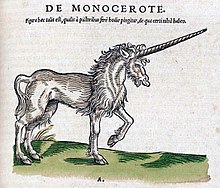
The horn of the unicorn is shown as a snail-like twist and tapering to a point at the front. It should be white and up to half a meter long. With it, the unicorn should be able to fight, heal and even reanimate its enemies (including lions ). The horn should only grow gradually in the unicorn's life ; a broken horn should grow back within ten years.
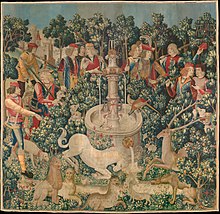
The horn as a drinking vessel is said to have healing powers against diseases such as the plague and leprosy . It should also make insensitive to fire and poison. In the Physiologus it is written that water poisoned by a snake loses its poisonous effect if the unicorn hits a cross in the water with its horn.
In the Middle Ages and the early modern period, the narwhal's tusk was thought to be the mythical horn and was called the ainkhürn . Several objects still exist today, mostly rulers' insignia made from narwhal tooth. In particular, the spiral structure of the narwhal tusk, which can be found in almost all artistic representations, suggests that these horns could have promoted the myth. Narwal teeth attributed to unicorns were also popular pieces in the princely chambers of wonder in Europe.
- Two crusaders in Constantinople stole two narwhal tusks, which they believed to be the horns of the unicorn, and donated them to St. Mark's Basilica in Venice , where they are still kept today (Treasury of St. Mark's Basilica).
- The Habsburgs also owned an “Ainkhürn” tusk and several objects from Ainkhürn ( Vienna Crown Treasure ).
- In 1671, the Danish King Christian V was crowned on a coronation chair made exclusively from Ainkhürn. It still serves as the throne of the Queen of Denmark today .
Magical abilities were ascribed to the Ainkhürn, for example that it could neutralize poison, which is why drinking vessels were made of narwhal ivory. Since the horn very versatile remedy was, were in many cities pharmacies Unicorn pharmacy named, as appropriate, corresponding sculptures on their buildings. It was not until 1638 that the Danish doctor and naturalist Olaus Wormius showed that the alleged unicorn horns were in fact tusks of narwhals.
The unicorn in art
In the visual arts , the unicorn appears in the cult caves of the hunter tribes. In the Pergamon Museum in Berlin it can be seen on the Ishtar Gate from Babylon.
Probably the oldest representation of a unicorn in Christian art can be found in an antiphonal from the 12th century in the Einsiedeln monastery . The miniature painting shows a scene of the Annunciation with Mary protecting the unicorn in her lap. The Archangel Gabriel kneels in front of her . As here, the unicorn is often depicted in art in the context of virginity. This allegorical motif goes back to the Physiologus.
In the Middle Ages the unicorn was therefore the symbol for the Virgin Mary, and also for Christ himself. You can find it on the brooch of the picture by Stefan Lochner Madonna in the Rosenhag (around 1448, Wallraf-Richartz-Museum , Cologne). The painting Lady with the Unicorn by Raphael (around 1506, Galleria Borghese , Rome) is famous . The unicorn can also be found on the panel painting The Garden of Earthly Delights by Hieronymus Bosch (around 1500, Prado , Madrid) and Lucas Cranach the Elder ( Das Paradies , 1530, KHM ).
The triumphal chariot of chastity (pudicitia) is regularly pulled by unicorns.
The Musée national du Moyen Age in Paris presents a well-known depiction of a unicorn : the series of five tapestries depicting the five senses and a sixth rug that combines all five senses. The carpets were made for Jaen Le Viste by Lyon and therefore also bear his coat of arms. Copies of the carpets are used as backdrops in many films, such as the Gryffindor common room in the Harry Potter films .
More unicorn carpets can be found in The Cloisters in New York and depict the unicorn hunt.
The unicorn motif can also be found in altars (e.g. unicorn altar in Erfurt Cathedral , early 15th century) and in sculpture (e.g. in the unicorn fountain by Prof. Geibel (1960) in Darmstadt ).
A unicorn sculpture crowns the Culross market cross .
zoology
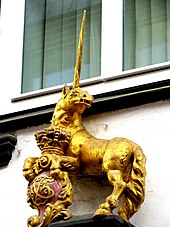
In 1827, the French paleontologist Baron Georges Cuvier tried to prove that unicorns could not have existed. His argument: unicorns are usually portrayed as ungulates. But these have a browbone divided in the middle, on which a horn would not find any support.
However, the American biologist Franklin Dove was able to show in a practical experiment in 1933 that Cuvier's argument was wrong. He took the horn buds of a newborn bull calf and transplanted them into the center of the skull. A single, straight horn developed.
In the mid-19th century, Johannes Leunis made a forgotten, but perhaps correct, zoological determination of the unicorn based on size, coat color, pair frequency and spatial distribution. According to him, it is the Beisa antelope from the genus of oryx , but more likely, according to Josef H. Reichholf, is the Arabian oryx ("body milk-white, neck and nose rust-brown; deer size, Arabia"). The long, straight horns look like a horn on the Egyptian reliefs. The reliefs also give an indication of how the antelope could become a mythical animal: It could not be tamed or domesticated. Domestication would have been desirable, especially in the desert, as the animals got along with little food and without water for months.
The narwhal , whose "horn" (or tusk; actually the left incisor) was used for a long time to meet the demand for unicorn products, is also called "unicorn (of the sea)" and bears the scientific name Monodon monoceros (ancient Greek: monoceros unicorn).
The unicorn in heraldry

In coats of arms the unicorn is a " common figure ". The shield of the British national coat of arms is held by a lion and a unicorn, the unicorn symbolizing Scotland . At the Palio di Siena (horse race in Siena) there is a contrada (neighborhood community) with the coat of arms of the unicorn.
See also
literature
- John Wilhelm von Müller: The unicorn viewed from the historical and scientific point of view. Stuttgart 1853.
- Max Wellmann : Unicorn . In: Paulys Realencyclopadie der classischen Antiquity Science (RE). Volume V, 2, Stuttgart 1905, Col. 2114 f.
- Odell Shepard : The lore of the Unicorn. London 1930.
- Symbolic research
- Winfried Hagenmaier: The unicorn. A search for traces through the millennia. Eulen Verlag, Munich 2003.
- Carl Cohn: On the literary history of the unicorn. Gaertner, Berlin 1896 ( digitized version )
- Rüdiger Robert Beer : Unicorn. Mythical world and reality. Georg DW Callwey, Munich 1972.
- Jochen Hörisch : The animal that doesn't exist. A text & picture collage about the unicorn. Crater Library. Franz Greno, Nördlingen 1986, ISBN 3-89190-409-6 .
- Jürgen (Father Werinhard) Unicorn: Spiritalis unicornis. The unicorn as a bearer of meaning in literature and art of the Middle Ages. Wilhelm Fink Verlag, 2nd edition Munich 1990, ISBN 3-7705-3143-4 .
- Klaus Minges: The Collection of the Early Modern Age. Lit Verlag, Münster 1998, ISBN 3-8258-3607-X .
- Jacques Le Goff : knights, unicorns, troubadours. Heroes and wonders of the Middle Ages. From the Franz. By Annette Lallemand. Munich 2005, ISBN 3-406-53585-2 .
- Symbolic representations
- Karen Duve , Thies Völker: Lexicon of famous animals. Eichborn Verlag, Frankfurt am Main 1997, ISBN 3-8218-0505-6 .
- Hans Biedermann (ed.): Lexicon of symbols. With over 600 illustrations. Droemer Knaur Verlag, Augsburg 2000, ISBN 3-8289-4153-2 .
- zoology
- Josef H. Reichholf : Why people settled down. 2nd edition S. Fischer Verlag, Frankfurt am Main 2008, ISBN 978-3-10-062943-2 .
- Art history
- Thomas Blisniewski : The Virgin and the Unicorn. A Cologne pillow plate from the late Middle Ages in the Schnügen Museum in Cologne. In: Cologne Museum Bulletin. Reports and research from the museums of the City of Cologne (4) 2006, pp. 4–11.
Theater, films and fiction
- theatre
- La Licorne (The Unicorn). Ballet by Jacques Ibert
- The lady and the unicorn. Ballet by Jean Cocteau (1952)
- Movies
- The Last Unicorn ( animated film 1982), by Peter S. Beagle
- Legend (1985), with Tom Cruise and Tim Curry
- Nico the Unicorn (1995)
- Series
- music
- Film music from " The Last Unicorn "
- America : The Last Unicorn ( theme song )
- America: Where do Unicorns Go?
- America: Walkin 'man's Road
- Mia Farrow (voice actress): Now That I'm a Woman
- Jeff Bridges and Mia Farrow (voice actors): That's All I've Got to Say
- other
- The blue unicorn (ribbon)
- Silvio Rodríguez : Unicornio (Album)
- Rhapsody of Fire : The Last Winged Unicorn
- Wolfmother : White Unicorn
- Trevor Moss & Hannah Lou : The Lion and the Unicorn
- Satan's Wife (Band) : The golden Unicorn
- Music videos
- Novels
- Tracy Chevalier : The Kiss of the Unicorn . Roman, translated from the English by Ursula Wulfekamp. List Taschenbuch, Berlin 2005, ISBN 3-548-60536-2 (about the creation of the above-mentioned magnificent tapestries in France).
- Iris Murdoch : The Unicorn. (1963)
- Peter S. Beagle : The last unicorn (template for the cartoon) Hobbit-Presse in Klett-Cotta Verlag, Stuttgart 1975, ISBN 3-12-900740-7 .
- Peter S. Beagle: The last unicorn and two hearts (continuation of The last unicorn ) Klett-Cotta Verlag, Stuttgart 2012, ISBN 978-3-608-93920-0 .
- Peter S. Beagle: The Sonata of the Unicorn (story independent of The Last Unicorn )
- Tracy Chevalier : The Kiss of the Unicorn. List-Taschenbuch, Berlin 2005, ISBN 3-548-60536-2 .
- Terry Brooks : The Black Unicorn
- Wolfgang Hohlbein & Heike Hohlbein : Silberhorn
- Michael Ende : The Neverending Story (The stone Al'Tsahir is cut from the horn of a unicorn.)
- Joanne K. Rowling : Harry Potter . (In the Harry Potter world, the horns of the unicorns are used as a potion ingredient.)
- Haruki Murakami : Hard-Boiled Wonderland and the End of the World (The inner world of the protagonist is populated among other things by a herd of unicorns, in the outer world a unicorn skull creates the symbolic connection to the inner world.)
- stories
- Cees Nooteboom : The Lady with the Unicorn. Travel stories.
- Indica - by the Greek scholar Ktesias (around 400 BC). In: Indika , a fabulous description of India and its creatures , the first description of the unicorn can be found in literature .
- James Thurber : The Unicorn in the Garden ( original text )
- Rainer Maria Rilke : The lady with the unicorn. Insel, Frankfurt 1978, 1993, ISBN 3-458-19001-5 .
- Florian Russi : Alid's dream - 12 unicorn stories . Weimar 2005, ISBN 3-937601-22-8 .
- Linda Chapman : Star Tail and Star Children . Unicorn stories for children in several volumes.
- fairy tale
- The brave little tailor from the collection of the Brothers Grimm : The unicorn depicted here is depicted as evil and caught by a ruse when it runs in blind rage towards the tailor and rams its horn into a tree. There is no longer any way for the unicorn to escape from this situation.
Essays
- Josef H. Reichholf: Fabulous unicorn. Disenchantment of a myth . In: Die Welt , January 3, 2008
- Poetry
“O this is the animal that does not exist.
They did not know and loved every case
- his walk, his posture, his neck
down to the light of the silent gaze. "
Web links
- Pascal Gratz: De Monocerote - On the reception history of the unicorn (PDF file; 447 kB)
- Symbol research (Switzerland): unicorn
- Bruno Faidutti: Images et connaissance de la licorne ( Memento of March 2, 2000 in the Internet Archive )
- Aaron J. Atsma: Theoi Greek Mythology : Equus Unicorn
- David Badke: The Medieval Bestiary : Unicorn
- David Badke: The Medieval Bestiary : Monocerus
- Dave's Mythical Creatures and Places - Unicorns
- Mythic Creatures : Unicorns, West and East , American Museum of Natural History
- Klaus Minges: Church treasure and cutlery: The unicorn (PDF file; 65 kB)
Individual evidence
- ↑ Aristotle: Historia animalium (Περὶ Τὰ Ζῷα Ἱστορίαι, animal science ), II, 1 (499b): “Μονοκέρατα δὲ καὶ μώνυχα ὀλίγα, οἷον ὁ Ἰνδικὸς ὄνος. Μονόκερων δὲ καὶ διχαλὸν ὄρυξ. "" There are a few equines with one horn, like the Indian donkey, two-hoofed animals with one horn only one oryx [= unicorn]. "(Translation by Hermann Aubert and Friedrich Wimmer )
- ↑ Caius Plinius Secundus: Naturalis historia ( Naturgeschichte ), VIII, 76 (chap. 31): “ Asperrimam autem feram monocerotem, reliquo corpore equo similem, capite cervo, pedibus elephanto, cauda apro, mugitu gravi, uno cornu nigro media fronte cubitorum duum eminent. Hanc feram vivam negant capi. "" But the most unruly animal is the unicorn, which looks like the horse on the body, the deer on the head, the elephant on the feet, the boar on the tail, roars very strongly and in the middle of the forehead a 2 cubitus [≈ 90 cm] long horn. You shouldn't be able to catch it alive. ”(Translation by Georg Christian Wittstein)
- ↑ Claudius Aelianus: De natura animalium (Περὶ ζῴων ἰδιότητος, animal stories ) XVI, chap. 20. Compare the translation by Friedrich Jacobs: Claudius Aelianus Werke. Vol. 4: Aelian's animal stories. Stuttgart 1839, pp. 1042-1043 (From the animals of the interior of India and the Kartazonon).
- ↑ Ktesias: Indika IV, 53. Cf. Heinrich and Margarethe Schmidt: The forgotten pictorial language of Christian art. A guide to understanding animal, angel, and Mary symbolism. Beck, Munich 1981, p. 47.
- ↑ René Bloch: Unicorn . The New Pauly Encyclopedia of Antiquity . Metzler, Stuttgart 2010, vol. 3, col. 916.
- ^ Gaius Julius Caesar: De Bello Gallico VI, 26; see. Curt Woyte : Notes . In: the same (ed.): Gaius Julius Caesar: The Gallic War . Reclam, Stuttgart 1975, S. Heinrich and Margarethe Schmidt: The forgotten visual language of Christian art. A guide to understanding animal, angel, and Mary symbolism. Beck, Munich 1981, p. 47.
- ^ The Greek Physiologus . German translation after Friedrich Lauchert : History of the Physiologus . Strasbourg 1889, chapter 22 ( online ( memento of September 24, 2014 in the Internet Archive ), accessed July 7, 2015).
- ↑ Num 23.22 LXX , Hi 39.9-12 LXX , Ps 21.22 LXX . Note: In the Septuagint it says μονόκερως ( Gen. μονοκέρωτος), while elsewhere the form μονόκερος (Gen. μονόκερου) also exists.
- ↑ Num 23.22 VUL , Hi 39.9-12 VUL , Ps 21.22 VUL .
- ↑ Biblia, that is the entire Holy Scripture in German. Translated by Dr. Martin Luther from the Textus Receptus. Lufft, Wittemberg 1545. Provided on the Internet by Hans Jürgen Herbst. The fourth book of Moses, chapter 23, verse 22. God brought you out of Egypt / his freedom is like a unicorn ( Memento from December 20, 2015 in the Internet Archive ). The book of Job, chapter 39, verse 9. MOnly the unicorn will serve you / and will stay at your manger? ( Memento of December 20, 2015 in the Internet Archive ) Ps / 22/21 The Psalter, Psalm 22, verse 22. Help me out of the jaws of Lewen / Vnd save me from the unicorns ( Memento of December 20, 2015 in the Internet Archive ) .
- ↑ a b René Bloch: Unicorn . The New Pauly Encyclopedia of Antiquity . Metzler, Stuttgart 2010, vol. 3, col. 916.
- ↑ GEOlino.de Jens Wiesner: Mythical creatures: The unicorn - the truth behind the myth .
- ↑ Heinrich Sander: Kleine Schriften , Vol. 1, 1779. P. 101 f.
- ^ Theodore Ziolkowski: The carbuncle stone. In: Euphorion. Volume 55, 1961, pp. 306-309.
- ↑ Bernhard Dietrich Haage: Prolegomena to Anfortas' suffering in the 'Parzival' Wolframs von Eschenbach. In: Würzburger medical historical reports 3, 1985, pp. 101–126, here: pp. 113–115.
- ^ A b c Karen Duve, Thies Völker: Lexicon of famous animals . Eichborn Verlag, Frankfurt am Main 1997, ISBN 3-8218-0505-6 .
- ↑ Umberto Eco : The History of the Legendary Countries and Cities. Hanser, Munich 2013, p. 109.
- ^ Conrad Gesner: Thierbuch. Reprint of the 1669 edition. Schlütersche Verlagsanstalt, Hanover 1995, p. 77.
- ^ John Layard, Anne S. Bosch (eds.): A Celtic Quest , Spring Publications, Dallas (Texas) 1975, ISBN 978-0-88214-110-7 , pp. 76, 166 ( limited preview in Google book search ).
- ↑ schr: Locomore long-distance train Stuttgart - Berlin started . In: Eisenbahn-Revue International 2/2017, p. 98.
- ↑ General Conditions of Carriage of Locomore GmbH & Co. KG - Approved version. Status: November 8, 2016 ( Memento from April 30, 2020 in the Internet Archive )
- ↑ Marcus Rohwetter: Unicorns in the toilet. In: Die Zeit from May 11, 2017, p. 21.
- ↑ Sara Kreuter: Unicorn Trend: Ambassadors from the end of the rainbow in faz.net [www.faz.net/aktuell/gesellschaft/menschen/der-einhorn-trend- geht-immer-weiter-15053934.html] accessed on 2019- 12-04
- ↑ Alexandra Anna Enrica van der Geer: Animals in stone: Indian mammals sculptured through time. Brill, Leiden 2008, pp. 112-114.
- ↑ Cf. ECL During Caspers: The Indus Valley 'Unicorn': A Near Eastern Connection? In: Journal of the Economic and Social History of the Orient, Vol. 34, No. 4, 1991, pp. 312-350.
- ↑ Gautama V. Vajracharya: Unicorns in Ancient India and Vedic ritual. In: Electronic Journal of Vedic Studies (EJVS) Vol. 17, Issue 2 , 2010, pp. 135-147.
- ↑ Reichholf, pp. 213-226.
- ↑ A living legend in an Italian nature park , T-Online Nachrichten
- ↑ Lee Speigel: 'Unicorns' And Humans Once Walked The Earth Together… Sort Of. In: The Huffington Post. August 3, 2016, accessed August 3, 2016 .
- ↑ Gesner, p. 73.
- ↑ Arthur Henkel, Albrecht Schöne (ed.): Emblemata: Handbook on the art of symbolism of the XVI. and XVII. Century. Stuttgart 1967, Col. 420-424.
- ↑ Christina Becela-Deller: Ruta graveolens L. A medicinal plant in terms of art and cultural history. (Mathematical and scientific dissertation Würzburg 1994) Königshausen & Neumann, Würzburg 1998 (= Würzburg medical-historical research , vol. 65), ISBN 3-8260-1667-X , p. 208 f.
- ↑ Axel Garboe: Enhjörningen. Copenhagen 1915 (= Medicinsk-historical Smaaskrifter , 12).
- ^ Wilhelm Molsdorf: Christian symbolism of medieval art. Karl W. Hiersemann, Leipzig 1926, p. 23.
- ↑ www.symbolforschung.ch: Unicorn .
- ↑ Christina Becela-Deller: Ruta graveolens L. A medicinal plant in terms of art and cultural history. 1991, p. 209 (with reference to the Physiologus and the master of the unicorn hunt ).
- ↑ Christina Becela-Deller: Ruta graveolens L. A medicinal plant in terms of art and cultural history. (Mathematical and natural science dissertation Würzburg 1994) Königshausen & Neumann, Würzburg 1998 (= Würzburg medical-historical research , vol. 65), ISBN 3-8260-1667-X , pp. 205–209.
- ↑ Josef H. Reichholf u. a .: Article ( page no longer available , search in web archives ) Info: The link was automatically marked as defective. Please check the link according to the instructions and then remove this notice. In: Berliner Morgenpost , January 6, 2008.
- ↑ Lukas Feldhaus: Narwhals. Smelling tooth, hearing head. In: The time. Volume 51, December 8, 2016.
- ↑ Review of “The Last Unicorn” at sf-radio.net





